Mainframe (2004), Lion’s Gate (November 9, 2004), single disc, 44 mins plus supplements, 1.33:1 pan-and-scan, Dolby Digital 5.1, Not Rated, Retail: $9.98
Storyboard:
Popeye The Sailor battles the Sea Hag while looking for his lost Pappy in this CGI special.
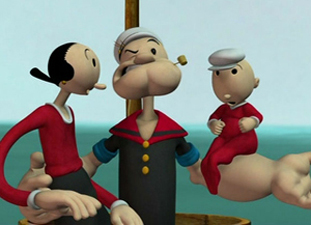
The Sweatbox Review:
And so it begins… Along with the latest direct-to-video Mickey Mouse extravaganza, November 2004 saw the debut of another classic cartoon property into the CGI world. Whether or not Popeye should have made this move was debated since this new film was first announced, and now curious DVD viewers can either have their fears confirmed or vanquished. Was Popeye’s Voyage: The Quest For Pappy the beginning of a great new chapter for the sailor, or a terrible misstep? The DVD from Lion’s Gate and Family Home Entertainment tells the tale…
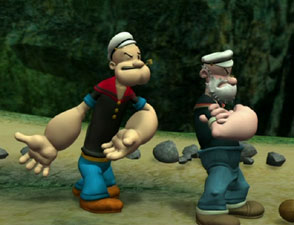
For the first time in almost twenty years, copyright owner King Features wanted to see Popeye back in animation, and this time they wanted a contemporary CGI look. They went with Mainframe in Vancouver, veterans of producing CGI shows for television and home video, working off a script by comedian/actor Paul Reiser and Jim Hardison. The story chosen was the classic tale of Popeye searching for his long-lost father, Pappy. While this seems like a safe choice, one wonders if a better one would have been a story that had not already been done by the Fleischers (in 1938’s Goonland), as well as the 1952 Famous Studios short Popeye’s Pappy, the 1960s TV cartoons (Me Quest For Poopdeck Pappy), and the 1980 live action film. Did we really need to see it again?
As the 44-minute film starts, Pappy is seen being chased by a near-sentient storm and sharks. Popeye tries to rescue him, but fails. Popeye wakes up from his dream at that point, with a new commitment to finding his father. He brings his boat, which also holds his first mate Bluto and adopted son Swee’Pea, to a seaside village. Once in town, there is a brief introduction for food-chasing Wimpy and what appears to be a cameo by old-time Thimble Theater regular Ham Gravy (Olive’s first boyfriend). Popeye then calls on his girlfriend Olive. Olive is not impressed by his plan to leave so soon again, especially just before Christmas, but she becomes more lenient when Popeye agrees to take her along. This does not sit well with Bluto, who does not care for the idea of either women or “landlubbers” on a boat.
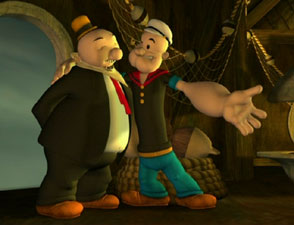
Wimpy stows aboard as they depart, and his food-searching becomes a running gag while never becoming an integral part of the story. The rest of the characters launch into a not-bad We’re Off To Rescue Pappy song that did not grate on me but also left little impression when it was done. They head towards the Sea Of Mystery, which legend has it is fraught with monsters and mayhem. Bluto is superstitious, but Popeye is undeterred, not believing in the myth of the Sea Hag that rules there.
Naturally, the Sea Hag is in fact spying on their approach, and sets up numerous obstacles including storms and a sea serpent. She even transforms into a siren to lure Popeye away, but his love for Olive protects him from her wiles. Eventually, Popeye begins to doubt his quest, but Olive and Bluto offer encouragement. Meanwhile, the Sea Hag decides that she must take Olive away from Popeye, and hatches a plan that will see that happen. Popeye becomes further dejected, especially when he later does find his Pappy on an island but is rebuffed by him too. We do learn soon why Pappy did not welcome Popeye, but his rejection makes Popeye all the more vulnerable to the Sea Hag. It will take the effort of all the good guys to save Popeye and help him find the will to fight again. Naturally, this includes a big “spinach” finale.

In the past few years, many people in the animation community have decried the move from hand-drawn animation to CGI, noting that the form of animation is not nearly so crucial to the success of a film as story and character. In that vein, one cannot criticize the new Popeye film simply for being done with computer-assisted animation. I know that many people do believe that this was a fundamentally bad move, but that seems hypocritical. Done well, there is no reason that Popeye could not translate to CGI— or stop-motion animation, for that matter. His creator never designed Popeye as an animated character, after all. Popeye was simply a bit player in a single storyline in the Thimble Theater newspaper comic strip, whose charisma saw him eventually take over the strip. Certainly, he translated exceedingly well to animation when the Fleischers re-invented him for their cartoon series of the 1930s, but creator E.C. Segar never envisioned this when he first drew Popeye.
Speaking of stop-motion, I found it most helpful to think of this production in those terms. As one of the animators notes in the special features, a CGI animator is really posing already-drawn models, a much different process than drawn animation where the character is recreated frame after frame. In those terms, the animation in Quest for Pappy works. There is not the traditional squash and stretch of the Fleischer shorts, but there is still a bounce and enthusiasm in the animation that one expects. There is also an effort to incorporate elements from the hand-drawn animation, including the classic birds-around-the-head gag (after being bonked on the cranium), elongating extremities, and clouds of dust during a fight.
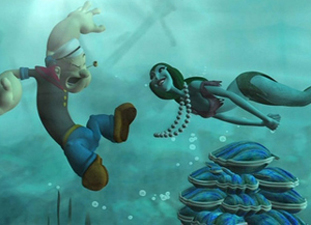
I found the character models to be pretty good. They all looked much like they should, right down to the black button eyes. Popeye speaks out of the side of his mouth like he should, has a lick of red hair, and has only one eye (which could not be said of the 1960s-era cartoons). Olive Oyl is even given rubber hose animation for her limbs, a nice throwback to the Fleischer era. The only odd thing that occurred in the CGI translation is that the cleft of Popeye’s chin stays in the middle, rather than switching sides depending on the pose like when he is drawn (similar to how Mickey Mouse’s ears are not typically drawn realistically in his cartoons, but behave “realistically” in CGI).
The story is done well enough, although the humor scored only occasionally; but probably my main concern with the plot is the use of Bluto. He is far too friendly here (except for a scuffle at the beginning), and my anticipation of seeing him turn villainous at some point was never rewarded. Certainly, he and Popeye were often shown as pals in the old cartoons, but always with a strong rivalry that ended with Bluto betraying or challenging Popeye, necessitating a fight between the two. That is the classic relationship between the two characters. Having Bluto be Popeye’s faithful and supportive first mate is just wrong. The conflict that does develop between them in the second act involves magic, and Popeye gives up far too easily, quickly dismissing the idea of taking a poke at Bluto. Bluto does not even pursue Olive, only hesitatingly accepting her advances when she appeals to his ego. I tell ya, it just ain’t right! A bigger role for Wimpy would have been better, too, as his appearances could easily be edited out without changing the plot.

At least the voice actors were well cast for the three lead characters. Billy West (Ren & Stimpy, Futurama) is spot-on perfect as Popeye, taking over from long-time Popeye voice artist Jack Mercer. Tabitha St. Germain is very reminiscent of Mae Questrel’s Olive, and Gary Chalk makes a good replacement for Bluto’s Jackson Beck. Although I did not care for Sanders Whiting as Wimpy, the weakest link by far is Kathy Bates’ performance of the Sea Hag. Using her typically flat delivery for an animated malevolent character was a poor choice, and really brings down the show.

I have already mentioned that this story has been seen on screen a few times before, and here is a second reason for picking a different story: water. The water effects simply do not come off, and look uniformly fake. I understand that the animators did not want “realistic” water, but the look they went with is just too flat for the 3-D characters. It looks not bad in still frame, but the animation of the water straddles the line between cartoony and realistic too awkwardly, and ends up being totally unsatisfying. In a story that takes place almost exclusively at sea, this is a crucial problem. The result is a production that looks cheap and unprofessional. It hurts me to say so, because I respect the efforts and enthusiasm of all involved, but I just could not get past the water issue.
Even the failure of the water effects might have mattered less with more inspired layout. The actual animation is really quite good, but the staging is boring. CGI offers a great opportunity to move the camera around characters, or to make worm’s- or bird’s-eye view shots, but Quest shows little ingenuity in utilizing such techniques. Perhaps this is an issue of not enough time for planning and preparation, but such staleness of presentation is disappointing.

Is This Thing Loaded?
In an odd move, the features on this disc are slanted towards featuring animation from the often-dreadful 1960s-era television cartoons, rather than the Fleischer shorts that supposedly inspired this production. Four Classic Episodes includes a quartet of these cartoons from Executive Producer Al Brodax, each about five and a half minutes long. Three are directed by Seymour Kneitel, who generally did the better cartoons from that decade. It is easy to see why Spinach Greetings was chosen, featuring as it does the Sea Hag and a Christmas theme, with the Hag kidnapping Santa Claus. Popeye In The Grand Steeple Chase is a Jack Kinney short that sees Brutus sell Popeye a bad horse and then competes with him in a race. Valley Of The Goons has Popeye kidnapped to help with an illegal round-up of Goons, but naturally he saves the day instead. William Won’t Tell takes place in a mythical kingdom, where a grateful kiss for Popeye from the queen must be hidden from both the King and Olive. Considering their brethren from that era, this is a pretty good selection— but Fleischer cartoons would have been much more appropriate.

Behind the Scenes Interviews can easily be skipped, featuring only three brief clips of CGI Popeye or Olive answering questions. Well, it may be worth one smile.
The Making of Popeye’s Voyage (11:15) interviews the producers, animators, and voice artists behind the film. It is a good, if certainly not comprehensive, look at the production. All involved pay proper respect to the Fleischer cartoons, and yet the clips edited into the featurette are all from the 1960s TV cartoons! With all the Fleischer films that are in the public domain, why could none of them been shown instead? I am sure this was not an intentional attempt to deceive, but it is a major blunder.
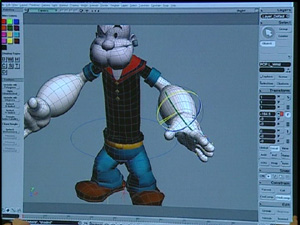
A Deleted Scene (1:58) is shown in storyboard form with a final voice edit. It involves Olive’s plans for decorating the boat. It is a decent scene, with one of the better jokes at the end, but the production is no poorer without it.
The Trailer Gallery has previews for both Popeye’s Voyage and Care Bears: JourneyTto Joke-A-Lot shown in non-anamorphic letterbox format.
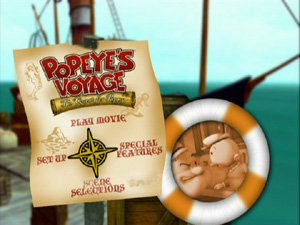
Case Study:
Standard keepcase, with a couple of Popeye-related ad inserts.
Ink And Paint:
The video is offered in 4:3 “fullframe”. This is a disappointment, since viewing the trailer on the disc shows clearly that this production was made for a widescreen presentation. Comparisons of shots confirm that image information has been lost from the sides. This resulted in my dropping the video score a couple of points. The video quality is otherwise generally excellent, devoid of any artefacts except for an instance of bad shimmering at the 34-minute mark.
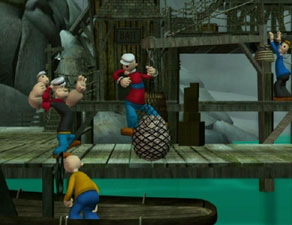
Scratch Tracks:
The soundtrack of choice is the English 5.1 track, but unfortunately for a 5.1 track it offers a mediocre stereo sound. The audio is very front-focused, and so the 5.1 track offers little more than the 2.0 one. There are a few directional effects, but they are used sparingly.

The songs range from mediocre to fair. We’re Off To Rescue Pappy is perhaps the best of them, while the lullaby Popeye sings to Swee’Pea is unmemorable and totally extraneous, even if I did appreciate the attempt at a fantasy sequence. It was not really needed, though, as there are already a couple of dream sequences and a siren-induced fantasy included in the story.
Aside from the English 5.1 mix, the audio is also offered in English or Spanish 2.0, and there are English and Spanish subtitles.
Final Cut:
While not the total disaster many would have you believe, this production has a number of flaws. Poor water effects, misuse of Bluto, a weakly voiced villain, and a lack of pizzazz in staging bring this production down to a mediocre level. It was interesting to see how Popeye translated to CGI, but this is far from the best that could be done in that medium. I would not mind seeing Mainframe take another stab at it, or better yet get Steve Oedekerk to produce it instead. If a better product does not emerge, however, I would just as soon see Popeye stick to the 2-D world.
As for the disc, the sound is just okay, while the lack of a widescreen transfer is very frustrating. The bonus features look good at first, but suffer with the unforgivable replacement of Fleischer material by 1960s TV cartoons. This disc is worth a rental for the curious, but probably only big Popeye buffs will want to make a purchase of it.
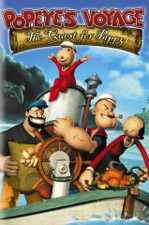 | ||
 |






